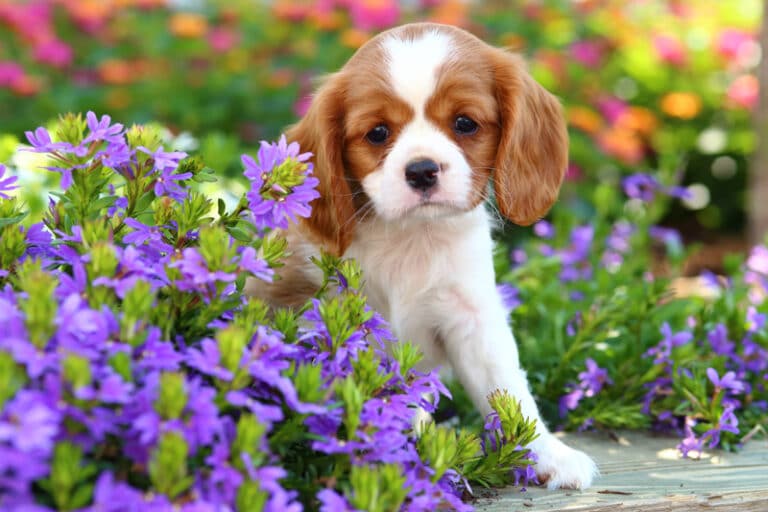Certain plants and flowers are harmful to your dog’s health, and an inspired solution is to put them in a place that is inaccessible to him. The safest solution is to choose to beautify your garden only with plants recommended for dogs.
The dose is poisonous. However, it is important to know what toxic substance the dog ingested. If you want your veterinarian to treat the ingested poison exactly and you want to know which plants you should avoid at home, take a look at the list of the most important poisonous plants for dogs.
While they are mainly natural beauties, perceived for the eyes and smell, for the dogs, the flats can be a real danger. Dogs explore plants and flowers with their noses and sometimes with their snouts. To prevent the risk of poisoning, we will list here the most common flowers, plants, and shrubs that contain toxic substances for dogs.
Anyone who has a dog in the house should take every precaution to avoid the risk of poisoning. Young animals are especially exposed to this risk because they are the most curious. They will smell and eat the plants. They will dig into the ground and can eat toxic tulip bulbs.
However, adult specimens may suddenly become interested in plants due to boredom, for example. The dog vomits immediately after eating a poisonous plant and this prevents further poison from entering the body.
- If your dog is caught eating poison, it should be removed immediately from the animal.
- Do not discard the plant so that it can be identified by your veterinarian.
- The dog, after eating a toxic plant, may experience the following symptoms: heavy salivation, vomiting, or diarrhea.
- You will need to act immediately and see a veterinarian.
- In case of muscle spasms, convulsions, or unsafe gait, the problem has worsened and should not be delayed for a minute.
- Write down the name of the plant and the time it was swallowed by the dog – this can save the dog’s life.
- Go to the vet as soon as possible.
CONTENT:
- Why protect your dog from plants banned by your veterinarian?
- Harmful plants
- How dangerous are plants that are toxic to dogs?
- First aid: what you need to do
Why protect your dog from plants banned by your veterinarian?
As you well know, dogs find great pleasure in gnawing at everything in their path. Fortunately, this trend is more present in the behavior of puppies. An adult dog will only start biting excessively when it feels frustrated and anxious because of certain changes that have occurred in its routine. Changes in the landscape of your garden can cause some anxiety, but they are welcome if they are made to protect their health. If you want a safe environment for your dog, but also flowers to color your garden, then you can prevent the tendency to gnaw on your quadruped by a simple method.
You can place a few logs in the garden, as well as wooden sticks, or toys with which he can spend his time in a pleasant way. The logs will give a rustic look to your garden, and your furry friend will find them very interesting. Even if you learn to be one step ahead of him, it is still possible for him to take your flowers by storm. That is why it is good to avoid plants that can harm your body.
The symptoms caused by ingestion of these plants are very unpleasant:
- excessive salivation;
- diarrhea;
- hallucinations;
- inability to breathe normally;
- convulsions;
- vomiting;
- mouth irritations;
- coma or even death.
It is obvious that such symptoms require an emergency visit to the vet. If your quadruped has ingested too much of the harmful plant, the consequences can be fatal.
Harmful plants
To avoid these symptoms and emergencies, the safest solution for everyone is to keep the following plants away from your garden:
- Japanese vines;
- narcissus;
- delphinium or nectarine;
- Lily;
- lobelia;
- apricot;
- azalea;
- bitter cucumber;
- tomatoes
All these are outdoor plants included by veterinarians in the list of plants harmful to pets.
How dangerous are plants that are toxic to dogs?
Each plant has its own toxin, which can be found in its leaves, flowers, and fruits. Once these toxins enter the bloodstream, they can cause serious organ damage.
Herbal poison often disrupts liver, kidney, or heart function. Therefore, a higher dose can cause a fatal cardiac arrest or kidney failure, which could endanger the life of the dog.
First aid: what you need to do
If the quadruped has eaten a poisonous plant in the last few hours, try to trigger the dog’s regurgitation reflex. You can add table salt to lukewarm water until a saline solution is formed. Spoon the dog over the vomit solution.
Important: In the meantime, you should contact your veterinarian, who may administer additional emetics or pump his stomach. Additionally, charcoal tablets and infusions can help absorb or remove toxic substances.

